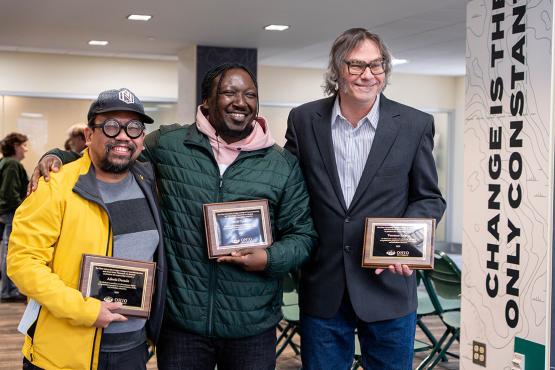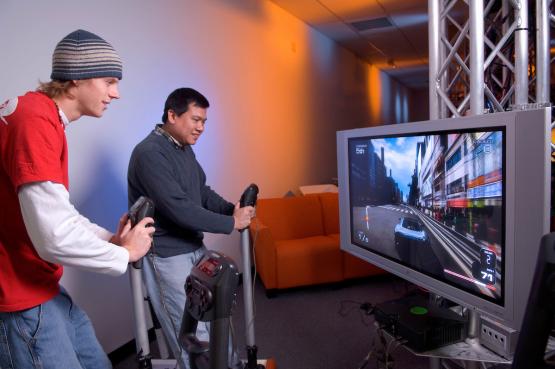
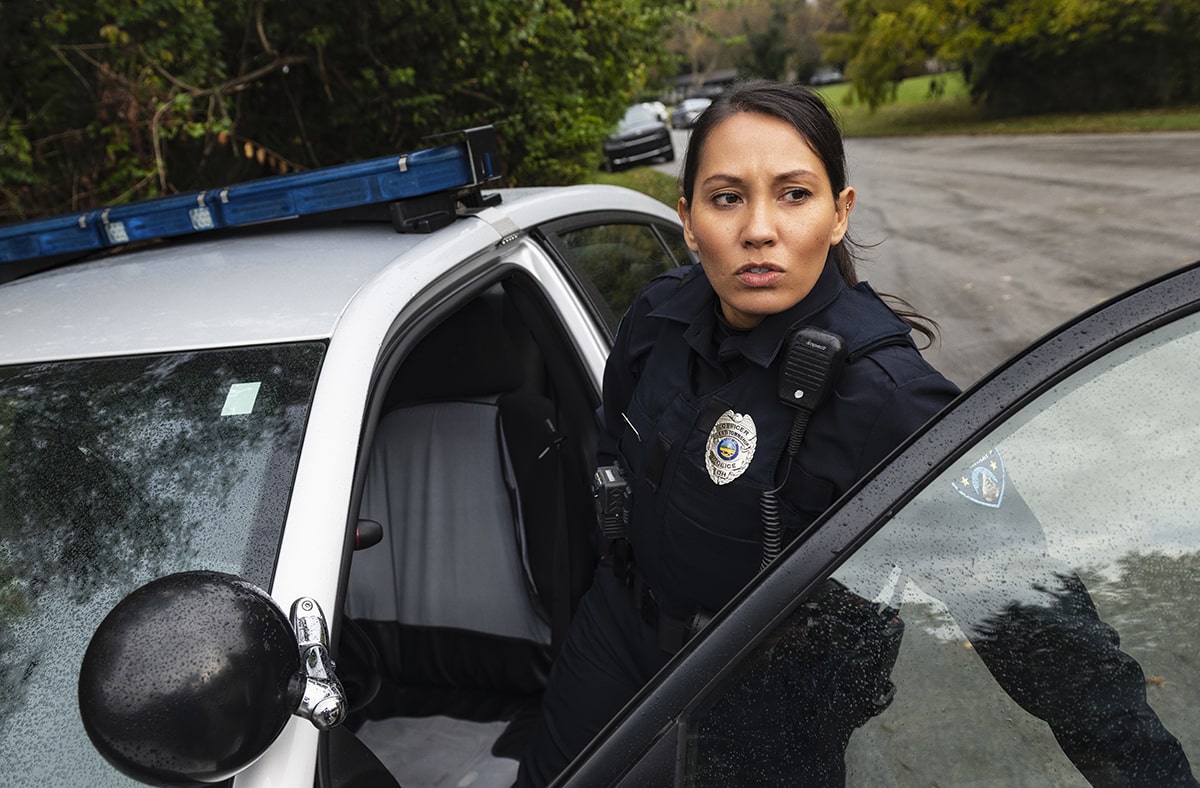
Virtual reality for real-world policing: OHIO’s next-gen VR training to be provided to 30,000 officers across the state
An immersive, scenario-based virtual reality training series developed by Ohio University will serve as the centerpiece for the State of Ohio’s “Ohio Peace Officer Training Academy (OPOTA),” a program that will help train approximately 30,000 law enforcement professionals across the state.
Sarah Filipiak BSJ '01, BS '23 | May 22, 2024
Share:
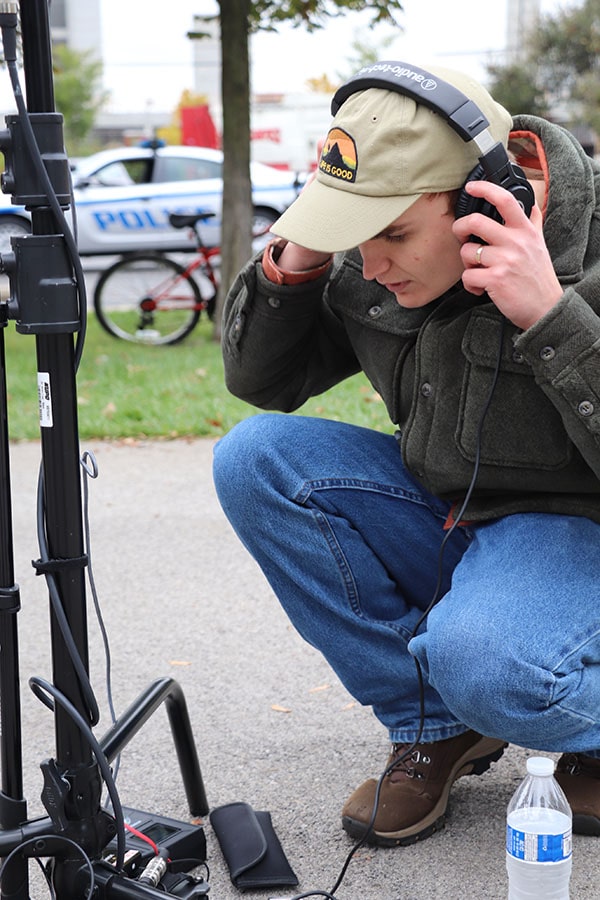
Ohio University Immersive Media Producer and Immersive Audio Specialist Jordan Herron on set. Herron served as Ambisonic Audio producer for the series of cinematic virtual reality (Cine-VR) episodes.
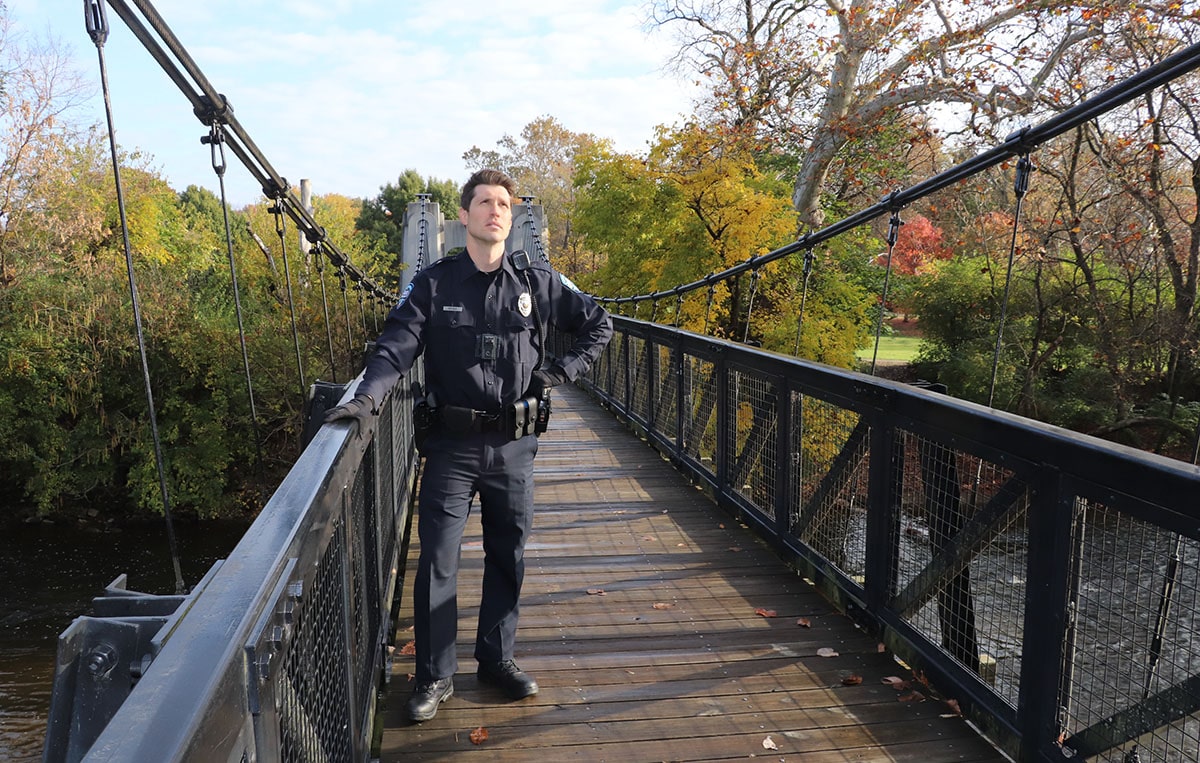
Officer Mike Regan, played by Nick Steen, stands on a bridge featured in the episode, "Jumper on High Plains Bridge," one of six new Cine-VR trainings now available to law enforcement across the state of Ohio.
A collaborative effort with far-reaching implications for policing
The scripted Cine-VR scenarios are a combined endeavor between Ohio University's Scripps College of Communication McClure School of Emerging Communication Technologies, Voinovich School of Leadership and Public Service, the Athens Police Department, Ohio University Police Department and the Athens County Sheriff’s Office. The Columbus Division of Police also collaborated on the filming.
The training series itself was developed in partnership with the Voinovich Academy for Excellence in Public Service and the Game Research and Immersive Design (GRID) Lab OHIO 360 Project, an award-winning Cine-VR program to provide immersive virtual reality training for law enforcement officers in Appalachia.
“It is as close to actually being in one of these kinds of scenarios as you’re ever going to get,” said David Malawista, a reserve commander with the Athens Police Department and a clinical and forensic psychologist. Malawista served as a consultant to lead writer and McClure School Professor Eric R. Williams in developing the scenarios, along with Captain Tim Ryan from the Ohio University Police Department and Captain Aaron Maynard of the Athens County Sheriff’s Office.
“If you’re immersed in [the scene], it’s very different than if you read it in a book or see it on a 2D screen. You’re there, you experienced it, it's like you’re absolutely there,” Malawista said.
It is as close to actually being in one of these kinds of scenarios as you’re ever going to get.
The virtual reality training, which includes a viewing discussion guide, is used to complement the Academy’s tactical and kinetic exercises. The point of the new training format, Malawista said, is to allow officers to practice responding to and defusing potentially volatile scenarios by using crisis-management techniques. “We want to teach officers to read people’s emotions and emotional states, and learn how to de-escalate,” he said.
Tracy Plouck, dean of the Voinovich School of Leadership & Public Service, noted that this innovative approach can improve how law enforcement officers gain valuable training experience. “Broadly embraced by veteran and rookie officers alike, [Cine-VR training] provides lessons and perspective critical for preventing bad things from happening,” Plouck said. “This is an example of how Ohio University is impacting Ohio in a positive way.”
VR technology that travels beyond the classroom
National studies demonstrate that “soft skill” Cine-VR training improves learning in a classroom setting, that Cine-VR learners are confident in applying that learning, and they are more likely to recall the experience more vividly.
“I think we’re just starting to understand the significance of this new medium,” said Williams, the author of two books on Cine-VR. “Imagine the impact on a person if they remembered movies as if they were real life. That’s what we see happening with cine-VR.”
Williams noted this type of memory recall differs from that of simply watching a scenario unfold in a traditional on-screen format, agreeing with Malawista’s assessment that people remember Cine-VR stories as if they had lived them.
“I first started to get a glimpse into that phenomenon when I heard people talk about their [Cine-VR] experiences,” Williams said. “They said things like, ‘Remember when we were on the bridge?’. You don’t say that with a movie. You say, ‘Remember that scene on the bridge?’. It’s a subtle difference, but I firmly believe that science will eventually discover that this technology is much more powerful than we currently understand.”
I firmly believe that science will eventually discover that this technology is much more powerful than we currently understand.
"People are starting to talk about how powerful virtual reality is in officer training, but nobody is doing what we’re doing yet,” Malawista said of Ohio University’s work in the Cine-VR realm.
With added instruction materials, the Cine-VR scenarios will be embedded into more than two dozen OPOTA courses. The state mandates 24 hours of training each year for officers. OPOTA purchased 160 headsets into which the training scenarios will be preloaded, and the organization plans to circulate the headsets statewide.
“These VR goggles are the next best thing to real-world experience because officers are immersed in split-second decision-making scenarios,” Attorney General Dave Yost said in a May 15 news release. “If someone makes a mistake while using virtual reality, it doesn’t have consequences in the real world.”
The OHIO360 Program was also recognized for it’s work in virtual reality at the 2024 Urban Media Makers Film Festival in Atlanta. The Cine-VR story “Police Dispatch,” depicting the day in the life of two officers on patrol, won the Best Virtual Reality Training Video award.
Unique law enforcement trainings, one-of-kind impact
One unique component of the Cine-VR trainings, in addition to the 360-degree, immersive experience they provide, is the use of graphics displayed on screens to illustrate the speaker’s emotional states. In one harrowing scene from the training videos, a young lady sits on a 40-foot tower, contemplating whether to jump, while an officer attempts to coax her to safety. Color-coded graphics on the side of the screen appear as she is talking. These serve to label the emotions she's expressing as she speaks, such as guilt, sadness, or hope.
“It’s really important that officers understand there are multiple emotional states [for someone in crisis], and that they fluctuate back and forth," Malawista said, noting that versions of the scenarios are available to watch with and without the graphics, to sharpen officers’ emotional intelligence skills. “First, you look at it and tell us what you see, now you can watch it with the graphics in a more concrete way,” he said.
What advice does Malawista have for officers in Ohio undergoing the Cine-VR training for the first time?
“Approach it with an open mind. Let it sweep over you,” he said. “What do you make of what happens when you arrive? What is going on here, and sometimes it’s much subtler and much more complex than it looks immediately.”
Updated at 10:42 a.m. ET on Nov. 12, 2024


